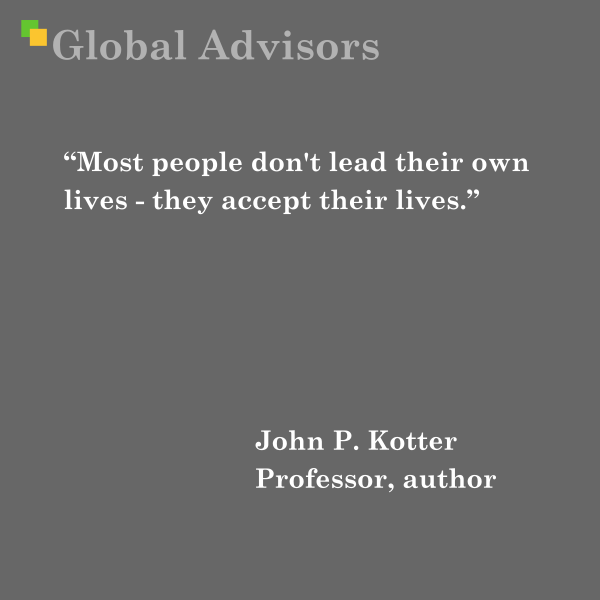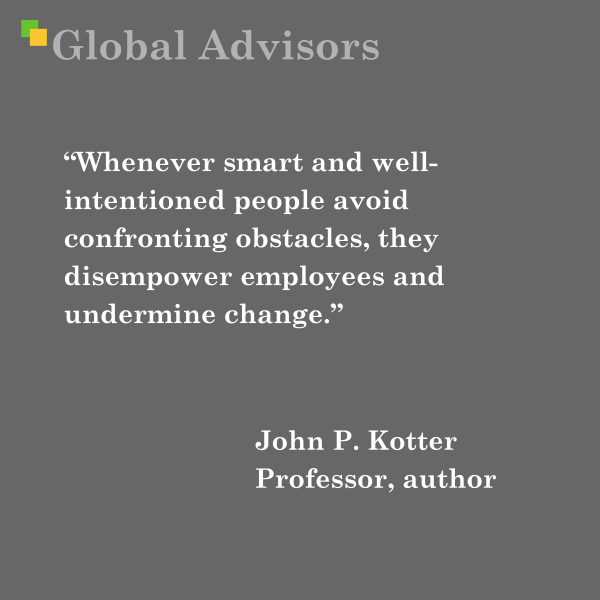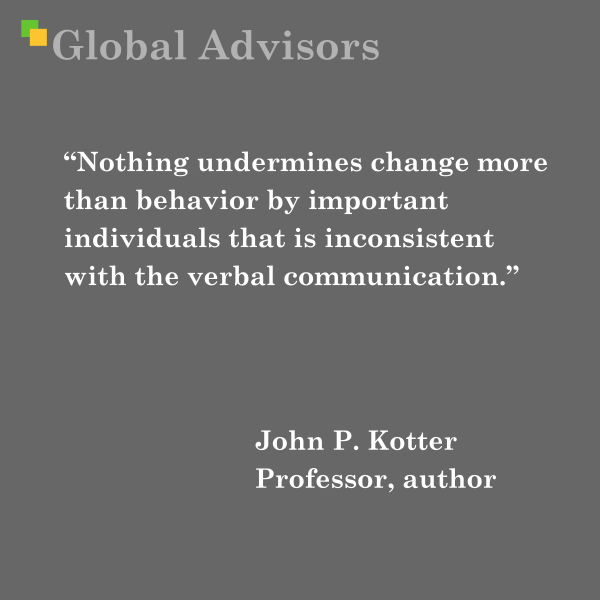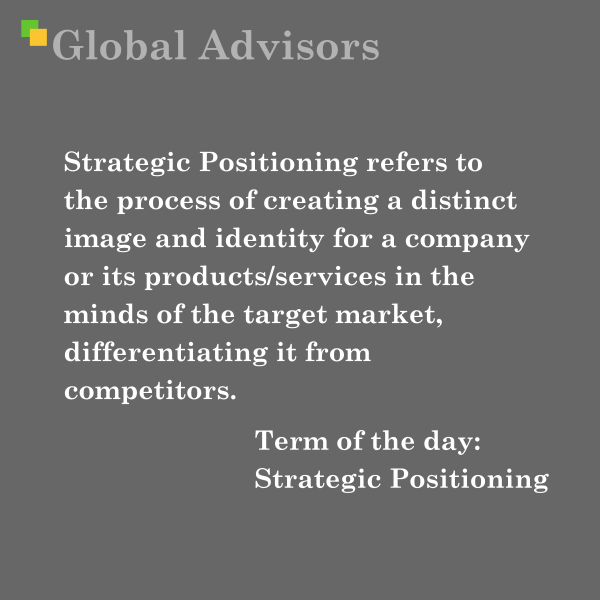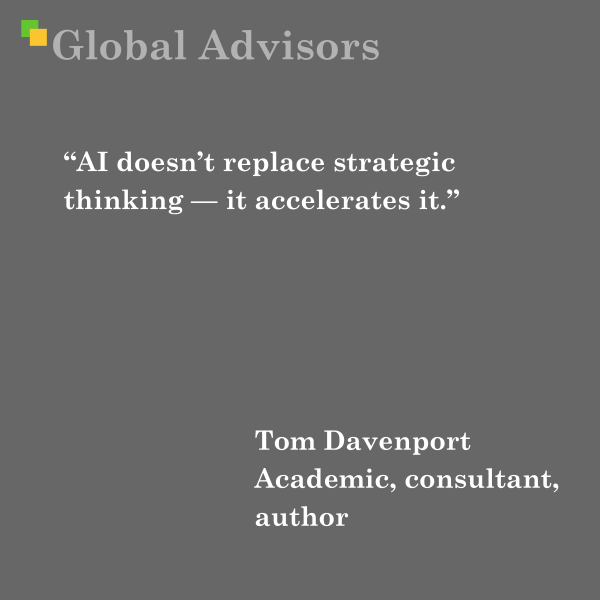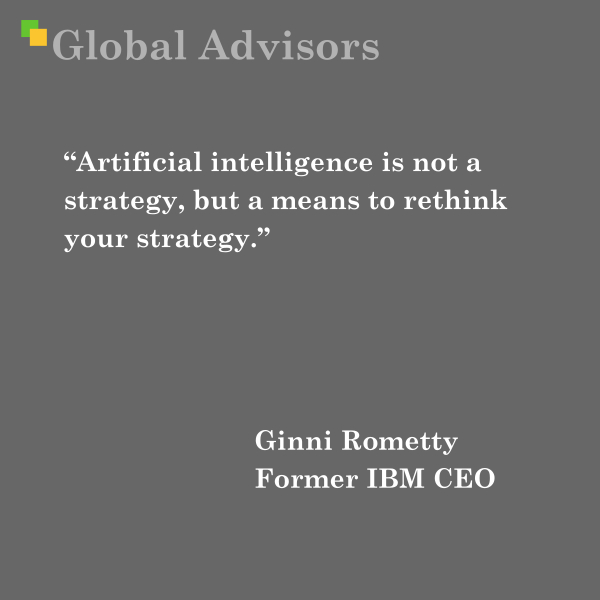| |
|
| |
| |
| |
|
Our selection of the top business news sources on the web. |
| |
| |
| |
Quote: John P. Kotter - Professor, author“Most people don't lead their own lives - they accept their lives.” - John P. Kotter, Leading ChangeJohn P. Kotter, a renowned professor at Harvard Business School and a leading authority on leadership and change, introduced this quote in his influential book, Leading Change. The book, first published in 1996, has become a cornerstone for understanding how individuals and organizations navigate transformation. Kotter’s work is grounded in decades of research into why change efforts often fail and what distinguishes successful leaders from those who merely manage. This particular quote captures a central theme in Kotter’s philosophy: the distinction between passively accepting circumstances and actively shaping one’s destiny. Through his research, Kotter observed that many people—whether in their personal lives or within organizations—tend to fall into routines, responding to external pressures and expectations rather than proactively setting their own direction. This tendency is not just a matter of comfort; it is often reinforced by organizational structures, cultural norms, and a lack of urgency or vision. Kotter’s eight-step process for leading change begins with the need to create a sense of urgency—a deliberate push to break through complacency and inspire action. He argues that true leadership is about envisioning a better future, mobilizing people toward that vision, and empowering them to act, rather than simply maintaining the status quo. In the context of this quote, Kotter is challenging individuals and leaders alike to reflect: Are you steering your life and work with intention, or are you simply drifting along with the current? Why This Matters: In Summary:
|
| |
| | |||||||||||||||||||||
Term: Price ElasticityPrice elasticity measures how sensitive customer demand is to changes in price. By understanding whether demand for a product is elastic (highly responsive to price changes) or inelastic (less responsive), businesses can optimize pricing to maximize revenue, profit and market share. Effective use of price elasticity enables data-driven pricing decisions, supports dynamic and value-based pricing models, and helps forecast the impact of price adjustments on sales and profitability. Comprehensive Outline of Pricing Elasticity in Pricing Strategy1. Definition and Core Concept
2. Importance in Pricing Strategy
3. Factors Influencing Price Elasticity
4. Pricing Strategies Based on Elasticity
5. Practical Applications
6. Measurement and Data Requirements
7. Strategic Implications
Summary:
|
|||||||||||||||||||||
| |
| |
Quote: John P. Kotter - Professor, author“Whenever smart and well-intentioned people avoid confronting obstacles, they disempower employees and undermine change.” - John P. Kotter, Leading ChangeJohn P. Kotter, a renowned authority on leadership and change management, wrote Leading Change after decades of observing why organizational transformations succeed or fail. This particular quote distills a core lesson from his research: the greatest threats to progress are not always external crises or a lack of intelligence, but the reluctance of capable leaders to face uncomfortable truths and challenges head-on. Context and Meaning Kotter’s work emerged from the realization that many organizations, despite being filled with talented and well-meaning leaders, routinely stumble when trying to implement change. He noticed that these leaders often sidestep difficult conversations, ignore persistent roadblocks, or hope that problems will resolve themselves. This avoidance, while sometimes motivated by a desire to maintain harmony or avoid conflict, actually produces the opposite effect: it erodes trust, saps morale, and stifles initiative at all levels of the organization. When leaders fail to confront obstacles—be they resistant managers, outdated processes, or cultural inertia—they send a message to employees that challenges are insurmountable or not worth addressing. Employees, seeing this, become disengaged and powerless, feeling that their efforts to drive change will not be supported or rewarded. Over time, this breeds cynicism and apathy, making meaningful transformation nearly impossible. Why This Insight Matters Kotter’s insight is rooted in his broader framework for successful change, which emphasizes urgency, open communication, and the removal of barriers. He argues that leadership is not just about setting a vision, but about actively clearing the path for others to act on that vision. When obstacles are ignored, they become institutionalized, turning into sources of frustration and resistance that can derail even the most promising initiatives. The quote serves as both a warning and a call to action. It urges leaders to model the courage and transparency they wish to see in their organizations. By confronting challenges directly, leaders empower employees to do the same, creating a culture where change is possible and everyone feels responsible for progress. The Broader Legacy Kotter’s message resonates beyond the boardroom. It applies to any context where people are working together to achieve something new—whether in business, government, or community organizations. The lesson is clear: progress depends not just on intelligence or good intentions, but on the willingness to face difficulties openly and to empower others to help overcome them. In summary, this quote encapsulates a hard-won truth from the front lines of organizational change: avoiding obstacles doesn’t protect people or projects—it undermines them. True leadership means confronting challenges, empowering teams, and clearing the way for real, lasting transformation.
|
| |
| |
Term: Nash EquilibriumNash equilibrium is a foundational concept in game theory describing a situation in which, in a game involving two or more players, no participant can improve their own outcome by changing their strategy as long as all other players keep theirs unchanged. In other words, each player's strategy is optimal in light of the strategies chosen by others. This leads to a stable outcome where no individual has an incentive to deviate. Related Theorist: John Nash The concept was developed by American mathematician John Nash, who proved that every finite game has at least one Nash equilibrium (possibly involving mixed or randomized strategies). He was awarded the Nobel Prize in Economics in 1994 for this work. Significance: Key Takeaway:
|
| |
| |
Quote: John P. Kotter - Professor, author“Nothing undermines change more than behavior by important individuals that is inconsistent with the verbal communication.” - John P. Kotter, Leading ChangeJohn P. Kotter’s insight, “Nothing undermines change more than behavior by important individuals that is inconsistent with the verbal communication,” emerges from decades of research and observation into the successes and, more crucially, the failures of organizational change. The quote is drawn from his landmark book Leading Change, published in 1996, which has become a foundational text for leaders seeking to guide their organizations through transformation. Kotter’s work identifies that a disconnect between what leaders say and what they do is among the most powerful barriers to lasting change. Through analyzing real-world case studies and transformation efforts, Kotter pinpointed three common failures in communicating a vision for change. The foremost, and most damaging, is this inconsistency between words and actions. When employees see leaders or influential figures contradicting their stated priorities, it sends a clear signal: the change is not truly important, sustainable, or worthy of commitment. In Kotter’s words, “Communication comes in both words and deeds. The latter is generally the most powerful form.” This is why genuine change requires leaders to embody the transformation they advocate, bridging rhetoric and reality through example. The context for Kotter’s statement is deeply practical. In his eight-stage process for leading change, he emphasizes that broad-based engagement and empowerment only take root when people see authentic and consistent commitment from those at the top. Otherwise, skepticism grows, cynicism takes hold, and even well-designed initiatives falter as employees wait for the ‘new direction’ to pass like others before it. The quote stands as both a warning and a call to action for leaders: model the change you wish to see. About John P. KotterDr. John P. Kotter is an acclaimed authority on leadership and change management. He has spent over forty years studying how organizations transform themselves to meet new challenges, and his research has shaped the field of change leadership. Kotter is a Harvard Business School professor emeritus and the author of several best-selling books, with Leading Change widely recognized as his seminal work. Among his most influential contributions is the “8-Step Process for Leading Change,” a framework distilled from observing and advising organizations across the globe. Kotter’s methodology continues to influence leaders in both the public and private sectors, helping them navigate the complexities of organizational change by focusing on urgency, coalition-building, vision, and—critically—authentic leadership by example. At its core, Kotter’s work is grounded in the belief that effective change doesn’t just happen through strategic plans or inspiring speeches. It relies on leaders who embody the changes they wish to see—turning words into meaningful, visible action
|
| |
| |
Term: Core CompetenceCore Competence refers to a unique set of skills, knowledge, or capabilities that a company possesses, which allows it to deliver unique value to customers and achieve a competitive advantage in the marketplace. This concept was introduced by C.K. Prahalad and Gary Hamel in their seminal 1990 Harvard Business Review article, "The Core Competence of the Corporation." They argued that companies should focus on identifying and nurturing their core competencies to build long-term strategic advantage, rather than just focusing on individual products or markets. Related Theorist: C.K. Prahalad and Gary Hamel In the landscape of business strategy, few ideas have had as lasting an impact as "core competence." This concept, articulated by C.K. Prahalad and Gary Hamel in their influential 1990 Harvard Business Review article, arose from the observation that many companies struggled to achieve sustained growth and innovation despite restructuring and cost-cutting throughout the 1980s. Prahalad and Hamel recognized that the real engine of long-term competitive advantage was not in organizational charts or product portfolios, but in the unique knowledge, skills, and capabilities embedded deep within an organization. They argued that the most successful companies were those able to identify, nurture, and leverage these core competencies—essentially, the things a company could do uniquely well, often difficult for competitors to imitate. Rather than pursuing a broad range of activities or simply reacting to market pressures, companies that focused on their core competencies could create new markets, deliver exceptional customer value, and withstand shifts in the competitive landscape. Prahalad and Hamel's insight placed a premium on the human side of organizations: expertise, collective learning, and collaborative problem-solving became strategic assets. Their work challenged executives to think beyond products and divisions, asking instead what underlying capabilities could be stretched across markets and geographies to fuel growth. For example, a firm known for its supply chain expertise or brand power could use those competencies to move into new industries or create entirely new product categories. Today, the idea of core competence is foundational in both academic strategy literature and practical management. It guides leaders as they assess strengths, build cross-functional teams, and prioritize investments, all in pursuit of sustainable competitive advantage. By understanding and harnessing what they do best, organizations can define their identity, differentiate themselves in crowded markets, and deliver unique value that stands the test of time
|
| |
| |
Term: Strategic PositioningStrategic Positioning refers to the process of creating a distinct image and identity for a company or its products/services in the minds of the target market, differentiating it from competitors. Michael Porter, a leading authority on competitive strategy, introduced this concept as part of his framework for achieving sustainable competitive advantage. Porter emphasized that strategic positioning involves making deliberate choices about which activities to perform and how to configure them to deliver unique value. This can be achieved through cost leadership, differentiation, or focus strategies (as outlined in his "Generic Strategies" model). Related Theorist: Michael Porter In the evolving landscape of business strategy during the late 20th century, companies grappled with the challenge of standing out in increasingly competitive and globalized markets. It was in this context that Michael E. Porter, a Harvard Business School professor, introduced the powerful concept of strategic positioning—a pivotal shift from simply competing to truly differentiating. Porter’s work drew upon microeconomics and industrial organization theory to analyze not just the structure of industries, but also how companies could outperform their rivals by making clear, deliberate choices about the value they create and how they deliver it differently than others. Prior to Porter, much of strategic thinking centered on participating in attractive industries and responding reactively to market pressures. Porter, however, reframed the discussion: firms should proactively define their position by deciding what unique combination of activities they would pursue—and, crucially, what they would not. This insight led to the articulation of the now-classic "Generic Strategies" model: cost leadership, differentiation, and focus. Porter’s research revealed that companies seeking to occupy a strong, defensible competitive position should commit to one of these strategies. Firms that failed to do so—who tried to “straddle” between methods—often found themselves “stuck in the middle,” lacking a clear identity or advantage. His frameworks, such as the Value Chain and the Five Forces, provided analytical tools to guide these strategic choices, moving beyond intuition to systematic, evidence-based decision making. Strategic positioning, as Porter defined it, is more than branding or marketing spin. It is about the underlying choices that shape a firm’s identity in the marketplace: the mix of products, the nature of customer relationships, and the configuration of activities that together create distinct value. Through this lens, competitive advantage is not a product of luck or circumstance, but of intentional differentiation and operational effectiveness. This approach transformed management thinking and remains foundational for firms seeking sustainable success. Strategic positioning continues to inform how organizations choose where to compete and how to win—emphasizing that in a crowded world, clarity of purpose, distinctiveness, and the courage to make trade-offs are the bedrock of lasting advantage
|
| |
| |
Quote: Tom Davenport — Academic, consultant, author“AI doesn’t replace strategic thinking—it accelerates it.” — Tom Davenport — Academic, consultant, authorTom Davenport’s quote captures the essence of the relationship between human judgment and advances in artificial intelligence. Davenport, a leading authority on analytics and business process innovation, has spent decades studying how organizations make decisions and adopt new technologies. As AI systems have rapidly evolved—from early rule-based approaches to today’s powerful generative models—their promise is often misunderstood. Some fear AI might make human thinking obsolete, especially in complex arenas like strategy. Davenport has consistently challenged this notion. He argues that AI’s true value lies in amplifying, not eliminating, the need for rigorous, creative, and forward-looking thought. AI is a tool that enables strategists to test more ideas, analyze larger datasets, and see farther into future possibilities—but it is strategic thinking, shaped by human experience and ambition, that guides AI toward meaningful goals. Davenport’s perspective is grounded in his extensive work with businesses and his scholarship at leading universities. In his conversations and writings, he notes that while AI democratizes access to information and automates routine analysis, a competitive edge still hinges on asking the right questions and crafting distinctive strategies. The leaders who thrive in the AI era are those who learn to harness its speed and breadth, using it to accelerate the cycles of planning, validation, and innovation rather than replace the uniquely human qualities of insight and judgment. About Tom DavenportTom Davenport, born in 1954, is an influential American academic, business consultant, and author. He specializes in analytics, business process innovation, and knowledge management. Davenport is well-known for his pioneering books such as Competing on Analytics and his widely-cited research on how organizations create value from data. Affiliated with prestigious institutions, he has helped shape how leaders think about information, technology, and business transformation. Davenport’s views on AI are informed by years of advising Fortune 500 companies, conducting academic research, and contributing to thought leadership at the intersection of technology and management. His insights have been instrumental in helping organizations adapt to the changing landscape of digital innovation, emphasizing that technology serves best when paired with human creativity, analytical rigor, and strategic vision
|
| |
| |
Quote: Ginni Rometty, Former IBM CEO“Artificial intelligence is not a strategy, but a means to rethink your strategy.” — Ginni Rometty, Former IBM CEOGinni Rometty’s statement, “Artificial intelligence is not a strategy, but a means to rethink your strategy,” emerged from her front-row vantage point in one of the era’s most significant technological transformations. As the first woman to serve as chairman, president, and CEO of IBM, Rometty’s nearly four-decade career at the company offers a compelling backdrop to her insight. Her leadership at IBM began in 2012, at a time when the company confronted industry-wide disruption driven by the rise of cloud computing, big data, and artificial intelligence. Rometty recognized early on that AI—while transformative—was not a plug-and-play solution, but a set of tools that could empower organizations to fundamentally reshape their approaches to competition, operations, and growth. This realization guided IBM’s pivot toward cognitive computing, analytics, and cloud-based solutions during her tenure. A defining episode during Rometty’s leadership was IBM’s acquisition of the open-source powerhouse Red Hat for $34 billion—a strategic move to anchor IBM’s transition into the cloud era and enable clients to rethink how they deliver value in increasingly digital markets. Throughout these changes, Rometty was adamant: adopting technologies like AI is not an end in itself but a catalyst for critically reexamining and reinventing business strategies. The quote distills her conviction that simply acquiring cutting-edge technology is not sufficient. Instead, success depends on leaders’ willingness to challenge old assumptions and design new strategies that fully leverage the potential of AI. Rometty’s perspective, forged by navigating IBM through turbulent shifts, underscores the necessity of using innovation to reimagine, not merely digitize, the future of enterprise. About Ginni RomettyGinni Rometty, born in 1957, joined IBM as a systems engineer in 1981 and steadily advanced through key leadership roles—culminating in her appointment as CEO from 2012 to 2020. During her tenure, she spearheaded bold decisions: negotiating the purchase of PricewaterhouseCoopers’ IT consulting business in 2002, prioritizing investments in cloud, analytics, and cognitive computing, and repositioning IBM for the demands and opportunities of the modern digital landscape. Her leadership style and vision earned her recognition among Bloomberg’s 50 Most Influential People in the World, Fortune’s “50 Most Powerful Women in Business,” and Forbes’ Top 50 Women in Tech. While her tenure included periods of financial challenge and criticism over IBM’s performance, Rometty’s overarching legacy is her focus on transformation—seeing technology as a lever for reinventing strategy, not merely executing it. This context enriches the meaning of her quote, highlighting its origins in both lived experience and hard-won leadership insight.
|
| |
| |
Quote: Andrew Ng, AI guru“In the age of AI, strategy is no longer just about where to play; it’s about how to adapt.” — Andrew Ng, AI guruThis quote from Andrew Ng captures a profound shift in how organizations and leaders must approach strategy in the era of artificial intelligence. Traditionally, strategic planning has focused on identifying the right markets, customers, or products—the “where to play” aspect. However, as AI rapidly transforms industries, Ng argues that the ability to adapt to ongoing technological changes has become just as crucial, if not more so. The background for this perspective stems from Ng's deep involvement in the practical deployment of AI at scale. With advances in machine learning and automation, the competitive landscape is continuously evolving. It is no longer enough to set a single strategic direction; leaders need to develop organizational agility to embrace new technologies and iterate their models, processes, and offerings in response to rapid change. Ng’s message emphasizes that AI is not a static tool, but a disruptive force that requires companies to rethink how they respond to uncertainty and opportunity. This shift from fixed planning to adaptive learning mirrors the very nature of AI systems themselves, which are designed to learn, update, and improve over time. Ng’s insight also reflects his broader view that AI should be used to automate routine tasks, freeing up human talent to focus on creative, strategic, and adaptive functions. As such, the modern strategic imperative is about continually repositioning and reinventing—not just staking out a position and defending it. About Andrew NgAndrew Ng is one of the world’s most influential figures in artificial intelligence and machine learning. Born in 1976, he is a British-American computer scientist and technology entrepreneur. Ng co-founded Google Brain, where he played a pivotal role in advancing deep learning research, and later served as Chief Scientist at Baidu, leading a large AI group. He is also a prominent educator, co-founding Coursera and creating widely popular online courses that have democratized access to AI knowledge for millions worldwide. Ng has consistently advocated for practical, human-centered adoption of AI. He introduced the widely referenced idea that “AI is the new electricity,” underscoring its foundational and transformative impact across industries. He has influenced both startups and established enterprises through initiatives such as Landing AI and the AI Fund, which focus on applying AI to real-world problems and fostering AI entrepreneurship. Andrew Ng is known for his clear communication and balanced perspective on the opportunities and challenges of AI. Recognized globally for his contributions, he has been named among Time magazine’s 100 Most Influential People and continues to shape the trajectory of AI through his research, teaching, and thought leadership. His work encourages businesses and individuals alike to not only adopt AI technologies, but to cultivate the adaptability and critical thinking needed to thrive in an age of constant change.
|
| |
| |
|
| |
| |

